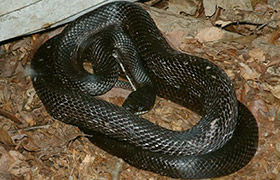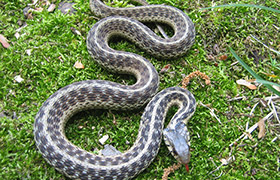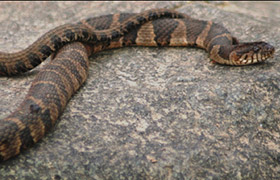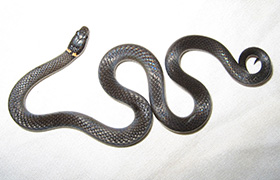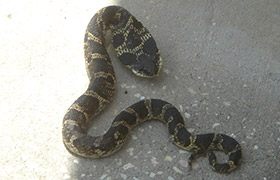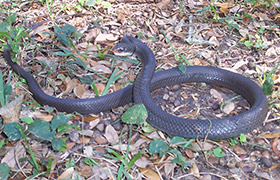Common Snakes of Pennsylvania: You will find snakes in most places you'll go to in the state of Pennsylvania and there's a good reason for that - there is a rich and diverse series of habitats which offer the perfect home with
plenty of food sources and somewhere safe to curl up. There are twenty-two species of common snakes of Pennsylvania but luckily, only three of them are known to be venomous. You’ll commonly find many of these snakes in residential
places such as rock walls, garages, outbuildings and barns, and other dry and dark locations especially during shedding. The snake will want somewhere quiet where it can go about its business without bing disturbed.
Venomous Snakes of Pennsylvania: As well as the non-venomous snakes you’ll find in the state, there are only three venomous species and these are the Copperhead, Eastern Massasauga Rattlesnake and Timber or Canebrake Rattlesnake,
venomous snakes also common in states such as Virginia, Ohio and Illinois.
Call the below number for snake removal help in your area:
Allentown: 610-927-7792
Harrisburg: 717-510-9658
Philadelphia: 610-927-7792
Pittsburgh: 412-228-4945
Reading: 570-240-4883
Scranton: 570-904-8590
Rat Snakes: Both the black and gray rat snakes can be found in Pennsylvania, and these feed on things such as lizards, mice, rats, copperhead snakes (venomous) and more. These rat snakes are actually very good in
keeping the numbers of dangerous snakes down (and away from residential areas) as well as keeping rodent numbers down too.
The snake sometimes looks a little like the copperhead snake to some people but the two shouldn’t be confused - the rat snake is not venomous whereas the copperhead is. As youngsters, you may spot rat snakes around
suburban areas - outbuildings, garages and sheds tend to be quite popular as well as getting inside residential properties too.
Garter Snakes: Probably the most commonly sighted snake in PA, and often referred to as a Garden Snake or Gardener Snake. Both the common garter snake and the striped garter snake can be found in this state, one that can come in
many designs and colors, but all have a stripe down the length of the back. Found more often than not in lawns and towns and suburbs, they eat frogs, toads, and other water-swelling creatures, meaning they can also be found in moist vegetation.
They also eat mice. They will lash out if threatened, releasing a musky, foul smell, but there won’t be any lasting damage and there is no venom to worry about. You may notice the following garter snake species in Pennsylvania: Eastern Garter and Short-Headed Garter
Northern Water Snake: These look like the highly venomous cottonmouth but you don’t need to worry, the northern water snake is entirely non-venomous and isn’t looking for a fight. It would take quite a lot to work this snake up
but if you harass it for long enough, it will coil up and snap. But these poor snakes are constantly mistaken for Copperheads in PA. I've walked the trails and streams and ponds of Pennsylvania for thirty years, and I'VE NEVER SEEN A SINGLE COPPERHEAD,
but I have seen hundreds of Northern Water Snakes.
Ringneck Snakes: Ringneck snakes are two very popular snakes across the entire USA and are also common snakes of Pennsylvania, often getting trapped within houses. It’s the insects and other small food items that draw snakes like these into residential areas - king snakes and
rat snakes eat small rodents and help to keep numbers down so where there are rodents, there is the chance of spotting a larger snake, but a smaller snake like a ringneck often finds its way under small gaps in doors and into houeses.
Eastern Hognose: Although it might behave like a venomous snake from time to time, the eastern hognose snake is actually pretty harmless if you leave it alone. When it feels threatened it will puff out its neck before coiling into a loaded spring, ready to strike. Generally however, it would rather find an escape route or, in cases where that’s not possible, the snake will even play dead, releasing a bowel movement and a ‘death scent’ to be as convincing as possible.
Northern Black Racer: A long and slender dark-colored snake that grows to about 60 inches in length (max), this is a common snake found in Virginia and has since spread out to close-by states. This snake is often confused with another similar colored and patterned snake - the eastern ratsnake, although this is less often found in the state with the Black Rat Snake being more commonly spotted.
Eastern Ribbon
Also known as the Common Ribbon Snake, the eastern ribbon is another of the common snakes of Pennsylvania, earning its name for being a long and thin snake that looks a bit like a ribbon, especially with the vertical lighter stripes. Another snake fond of wetlands, you may spot this one around streams, ponds, lakes and marshes, and generally eats small marine creatures such as tadpoles and small frogs or toads, salamanders, and, when the occasion calls for it, even small insects.
Eastern Milk
The eastern milk snake and, in fact, milk snakes in general, are very common across America with the eastern variety being quite prolific in the state of Pennsylvania. With striking patterns and bright colors, you’d be forgiven for confusing this species with a venomous one like the coral snake but it is a completely harmless species as long as you don’t threaten it.
For more information, go to my
Snake Removal - How to Get Rid of Snakes home page.
